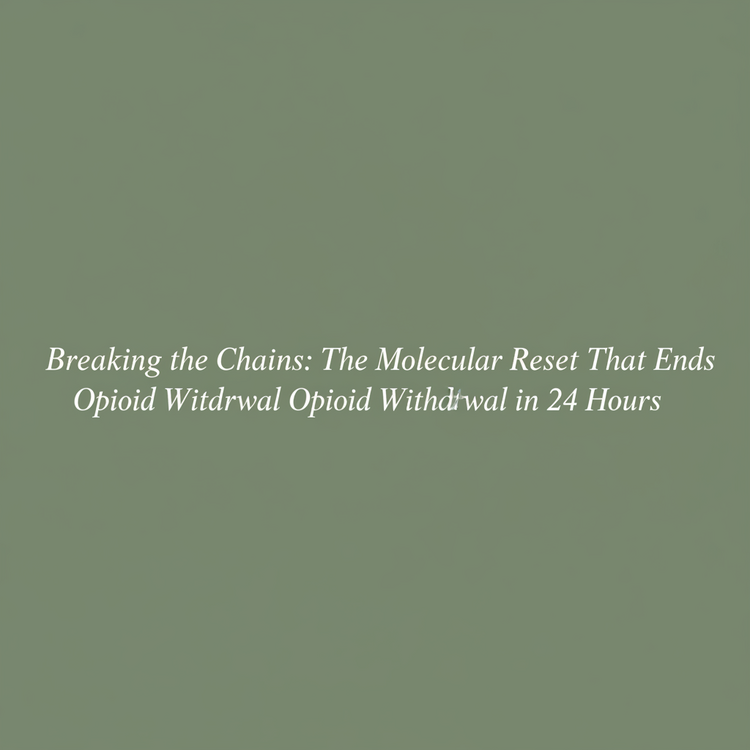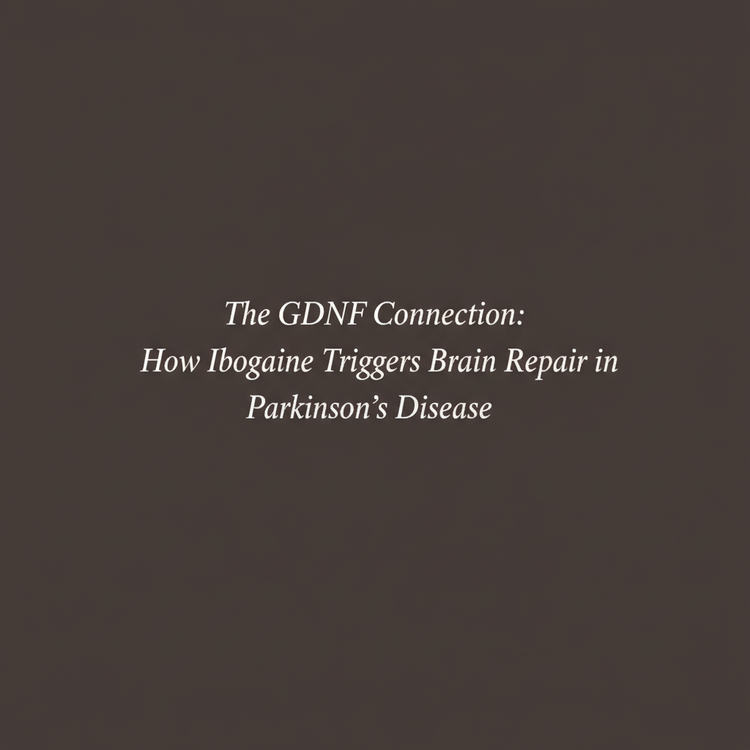Breaking the Chains: The Molecular Reset That Ends Opioid Withdrawal in 24 Hours

For anyone who has endured it, traditional opioid detox is a unique form of hell. It’s a week or more of unrelenting agony—physical and psychological—that most people cannot withstand. But the cruelest part isn’t the detox itself; it’s the crushing reality that even if you make it through, overwhelming cravings almost always drag you back. This isn’t a failure of willpower. It’s a failure of a medical approach that doesn’t address the root cause: addiction is a disease of hijacked brain chemistry.
Conventional treatment often involves tapering, managing symptoms with other drugs, or substituting one dependency for another with maintenance therapies like methadone or Suboxone. But what if there was a way to interrupt the addiction at its source? What if a single treatment could not only bypass the agony of withdrawal but also reset the neurological pathways that keep cravings alive? This is the paradigm-shifting promise of ibogaine therapy.
This article explores how one medically supervised session can achieve what months or years of conventional treatment often cannot: the complete cessation of withdrawal and a profound reduction in cravings, opening a genuine window for lasting recovery. We will delve into the science of this molecular reset and the clinical evidence that supports it as a revolutionary tool in addiction medicine.
The Vicious Cycle: Why Willpower Isn’t Enough
The standard model of opioid detox has a tragically low success rate, with some estimates placing long-term success as low as 5-10%. The process is brutal, forcing the body and mind through 7 to 14 days of intense pain, nausea, anxiety, and insomnia. Most people relapse not because they lack the will to quit, but because their brain’s fundamental architecture has been rewired by chronic opioid use.
Addiction creates deeply ingrained reward pathways that scream for the substance, while the parts of the brain responsible for impulse control are compromised. Maintenance therapies like Suboxone or methadone can be lifesavers, but they work by occupying the same opioid receptors, essentially replacing one chemical dependency with another. They manage the problem but rarely resolve the underlying neurological dysregulation.
Without correcting the brain chemistry that drives the obsession, relapse is often a matter of when, not if. This is the core failure of traditional approaches. They ask a person to fight a biochemical fire with willpower alone, a battle few can win. Studies reviewing novel treatments like ibogaine are born from the urgent need for an approach that does more than just manage symptoms—one that actually rewires the brain for recovery.
The Symphony of Healing: Ibogaine’s Multi-Receptor Action
Ibogaine’s power lies in its unique ability to interact with multiple brain systems simultaneously, creating a cascade of neurochemical events that interrupt addiction. Unlike pharmaceuticals that target a single receptor, ibogaine orchestrates a full-brain reset. The science behind this is as compelling as the outcomes.
Mechanism 1: Silencing the Cravings Engine (Kappa-Opioid Receptors)
The kappa-opioid receptor (KOR) is a key driver of the negative feelings associated with withdrawal and cravings—dysphoria, anxiety, and stress. When activated, it creates a powerful psychological pull to use again to escape the discomfort. Ibogaine acts as a KOR antagonist, effectively blocking this receptor. This is a critical reason why patients report that the mental obsession with opioids simply vanishes.
Mechanism 2: Rewiring Addiction Patterns (NMDA Receptors)
Ibogaine is also a potent NMDA receptor antagonist, a mechanism it shares with the rapid-acting antidepressant ketamine. The NMDA system is crucial for learning and memory—including the “learned” patterns of addictive behavior. By blocking these receptors, ibogaine interrupts the maladaptive neural circuits that sustain addiction, creating a space for new, healthy patterns to form.
Mechanism 3: The Noribogaine Advantage for Long-Term Stability
After being administered, the body metabolizes ibogaine into noribogaine, a remarkable compound that is key to the treatment’s lasting effects. Noribogaine has a long half-life, remaining active in the body for days or even weeks. It continues to interact with mu-opioid and serotonin receptors, which stabilizes mood and prevents the return of cravings long after the initial treatment is over. This “long tail” effect bridges the most vulnerable period of early recovery, giving individuals a crucial head start on building a new life without the constant threat of relapse.
Rebuilding the Brain: How Ibogaine Repairs Opioid-Induced Damage
Perhaps the most revolutionary aspect of ibogaine treatment is its ability to promote neurological repair. Chronic opioid use physically damages dopamine neurons, depleting the brain’s capacity to experience pleasure and reward from natural sources. This is why many in early recovery suffer from anhedonia (the inability to feel joy), a major driver of relapse.
Ibogaine flips this script by stimulating the production of powerful neurotrophic factors, or “brain fertilizers.” Research shows it significantly upregulates Glial Cell-Derived Neurotrophic Factor (GDNF) and Brain-Derived Neurotrophic Factor (BDNF). These proteins are essential for the growth, survival, and repair of neurons. By increasing GDNF levels, ibogaine helps heal the very dopamine-producing cells that opioids have damaged.
This isn’t just symptom management; it’s true neurological restoration. The outcome is profound: patients often report feeling “normal” or “like themselves” for the first time in years. Ibogaine doesn’t just stop the negative cycle; it helps restore the brain’s ability to feel positive, creating a sustainable foundation for recovery.
Beyond Theory: The Data on Real-World Transformation
The clinical evidence for ibogaine’s efficacy is compelling. In medically supervised settings, 80-90% of patients experience a dramatic reduction or complete elimination of withdrawal symptoms within 36 hours. This alone is a monumental shift from the week-long ordeal of conventional detox.
The long-term results are equally impressive. An observational study tracking individuals for 12 months after a single ibogaine treatment found remarkable outcomes:
- 41% achieved sustained abstinence for more than six months.
- Of those who remained abstinent, 54% maintained it for over a year, and 31% for over two years.
- Even among those who did relapse, 48% reported a significant decrease in their overall substance use.
These results, achieved from a single administration, far surpass the success rates of traditional methods. During the “flood dose” protocol, patients undergo a deeply introspective, oneiric (dream-like) experience that lasts 18-36 hours. Many describe this experience as one of the most meaningful of their lives, providing profound psychological insights into the root causes of their addiction. They don’t just wake up free from withdrawal; they often wake up with a new perspective on their life and future.
The Window of Opportunity: Why Treatment is Just the Beginning
Ibogaine is not a magic bullet; it is a powerful catalyst. It performs the near-impossible task of eliminating withdrawal and cravings, opening a critical neuroplastic window where the brain is primed to learn new behaviors and thought patterns. But the work of recovery begins the moment that window opens.
This is why post-treatment integration is essential. The clinical guidelines for ibogaine therapy emphasize the need for a comprehensive aftercare plan that includes therapy, coaching, and lifestyle changes. By removing the primary physical and psychological barriers to recovery, ibogaine makes the hard work of building a new life possible. It opens the door, but the individual must be prepared to walk through it with dedicated support.
For those ready to break the chains of opioid dependency and begin a new life, the first step is a conversation. Contact Iboga Wellness Institute at 800-604-7294 for a confidential consultation. Our medical team is here to understand your journey, explain our industry-leading safety protocols, and determine if this breakthrough treatment is the right path for you.
You can also download our Clinical Summary of Ibogaine Therapy for comprehensive information on mechanisms, safety, and evidence-based outcomes that are transforming addiction treatment.
Key Takeaways
- Ibogaine interrupts opioid addiction by eliminating withdrawal symptoms and cravings within 24-36 hours, a process that takes 7-14 days in conventional detox.
- Its effectiveness comes from its multi-receptor action, resetting addiction-related neural circuits and providing long-term stability via its metabolite, noribogaine.
- Ibogaine stimulates the production of GDNF and BDNF, neurotrophic factors that actively repair dopamine neurons damaged by chronic opioid use.
- Clinical studies show that a single treatment can lead to long-term abstinence in a significant percentage of patients, far exceeding the success rates of traditional methods.







